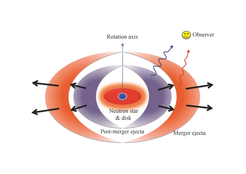Neutron-star mergers and high-energy astrophysics
Thesis research on this topic will involve the AEI, the University of Potsdam, and the Leibniz Institute for Astrophysics.
The combined observation of gravitational waves and electromagnetic signals from GW170817 provided us with unprecedented and unique information not only on the neutron star merger process, but also on the nuclear physics properties of neutron stars, and on the formation mechanism of heavy elements in the Universe (i.e., on nucleosynthesis). These observations heralded the era of multi-messenger astronomy, and demonstrated that gravitational waves and electromagnetic telescopes will play a central role in the next several decades, shading light on the strongest gravitating phenomena in nature.
To extract physical information from the gravitational waves and electromagnetic observations, we need to develop an accurate theoretical understanding of the merger and post-merger processes, notably the mass ejection mechanism, the associated nucleosynthesis of heavy elements, the physical mechanism responsible of launching short-hard gamma-ray bursts, and the nuclear-physics properties of neutron stars.

To achieve these goals, we have to solve a wide variety of equations, including Einstein’s field equations, magnetohydrodynamics equations, Maxwell’s equation, and neutrino radiation transfer equations. To study neutron star matter properties, we also need to take into account nuclear-theory–based equations of state for modeling neutron stars. To explore the nucleosynthesis of heavy elements that occurs when matter is ejected during the merger, we also need calculations of the nucleosynthesis. Furthermore, for modeling electromagnetic signals that are likely to be emitted from the merger remnants and the ejecta, we need to perform radiation-transfer simulations of photons. All those computations require large-scale computer simulations on high-performance computer clusters.

Graduate students in the IMPRS will be trained on those topics and acquire a broad knowledge of high-energy astrophysics, general relativity, strong interactions for high-density matter, weak interactions for neutrino-radiation transfer, and magnetohydrodynamics. They will learn how to perform large-scale simulations of physical phenomena involving strong gravity and high density matter. The students will play a central role in the new, exciting era of multimessenger astronomy.

